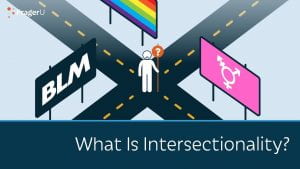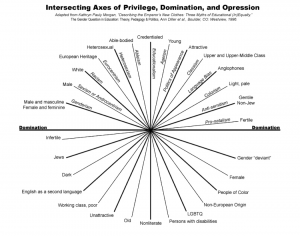Intersectionality and Connectivity :
Intersectionality is a feminist term used as a way of thinking about how our social identities interconnect. The term was coined by “Kimberle Crenshaw” she used it in her feminist theory researchDemarlginalizing the Intersection of Race and Sex: A Black Feminist Critique of Anti-discrimination Doctrine, Feminist Theory and Antiracist Politics The largest take away from intersectionality is that a person can experience multiple realities at one time simultaneously. What I mean by that is, a person can be oppressed in one category, for example me being a “woman” and yet can be privileged in the same breathe, that meaning I am a “cis gendered white person” In essence intersectionality can be viewed like a web and things that can overlap or connect to one another. Whether it be multiple oppressions or simply being “oppressed” and “privileged” simultaneously.
 Deeper Look into Intersectionality & Ecofeminism:
Deeper Look into Intersectionality & Ecofeminism:
The whole purpose behind activists and feminists like Crenshaw is to show the necessity of black stand point in feminist theories as well as anti-discrimination. In many ways ecofeminism theories and intersectionality are similar in their breakdown and beliefs. in a reading called ” Ecofeminism: Historic and International Evolution ” by Hobgood-Oster discusses the beginning of the environmental and ecofeminist theories and how they intersected. in this paper it explains one of the most important assertions that ecofeminist make. ” all forms of oppression are connected and that structures of oppression must be addressed in their totality. “( Hobgood-Oster). This is exactly what Crenshaw is explaining when she gives her example of the black woman who was in the court case “DeGraffenreid v General Motors” the judge could not understand that she was discriminated against because of two different oppressions, being black and being a woman. He could not see that because both black males were employees and as were white women. Crenshaw gave a Ted Talk where she explained intersectionality as a four way stop and I believe that is the simplest way of understanding. See the Image below:
The figure of a person is in the middle because each road is labeled and that person does not just have one social identity. They have multiple which is why the middle of the intersection is where they are. Both ecofeminism and intersectionality are multi-faceted and multi-located. Another way to look at intersectionality is through the image of the intersecting axes of Privilege, Domination, and Oppression.
More Ways to Look at Ecofeminism and Intersectionality
Throughout the course have discussed in many ways how the perception and description of woman is correlated to nature and earth and we see how the media in particular can describe woman in a way that fits the patriarchal society we live in. That is why looking at this “web” idea of interconnectedness we as individuals are so complex in our identities that you can not just simply categorize us to fit into one mold or box. It is not the easy, you must look at all aspects of our lives. As stated earlier intersectionality and ecofeminism are every changing and have a multitude of focuses. It is not just one area of focus but rather a wide range.
Bibliography
Cain, Cacldia. “The Necessity of Balck Women’s Standpoint and Intersectionality in Environmental Movements .” Black Feminist Thought 2016 (2016).
Hobgood-Oster, Laura. “Ecofeminism: Historic and International Evolution.” 31 January 2020 <http://users.clas.ufl.edu/bron/pdf–christianity/Hobgood-Oster–Ecofeminism-International%20Evolution.pdf>.


